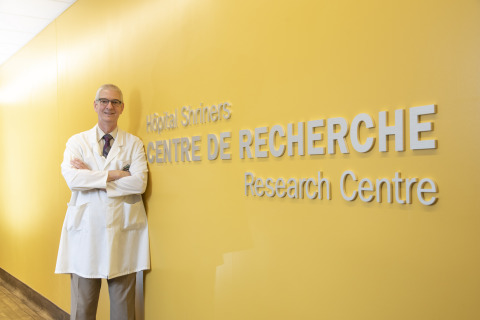
René St-Arnaud, Ph.D., Directeur de la recherche, Hôpitaux Shriners pour enfants Canada / Director of Research at Shriners Hospitals for Children - Canada (Photo: Business Wire)
Most people have broken a bone or know someone who has. A break is painful and takes time to heal. Recovering from a fracture is even more complicated and lengthy when your body is not able to produce what is needed to heal. More than 10% of fractures do not heal properly, and this percentage dramatically increases for patients, like those treated at Shriners Hospitals for Children®, who are affected by metabolic diseases. Improvements in the treatment of fractures are therefore highly beneficial. In a study published in the August 2018 issue of the Journal of Clinical Investigation, René St-Arnaud, Ph.D., Director of Research at Shriners Hospitals for Children – Canada shares his discovery of a new way to stimulate bone fracture healing.
This press release features multimedia. View the full release here: https://www.businesswire.com/news/home/20180726005275/en/

René St-Arnaud, Ph.D., Directeur de la recherche, Hôpitaux Shriners pour enfants Canada / Director of Research at Shriners Hospitals for Children - Canada (Photo: Business Wire)
The science
It is well known that vitamin D is produced in
skin when exposed to sunlight and is found in some foods that we
consume. In order to stimulate calcium absorption and benefit bone
mineralization, our body must transform the vitamin D molecule in two
steps.
During the first step of vitamin D transformation, another form of vitamin D, called 24,25(OH)2D, is created. Although 24,25(OH)2D has been mainly regarded as an inactive degradation product, the work from Dr. St-Arnaud’s laboratory has not only revealed that 24,25(OH)2D improves bone fracture healing but he has discovered how this process works.
With the help of another molecule, 24,25(OH)2D synthesizes a waxy fat compound called lactosyl ceramide. This compound triggers the transmission of a signal in order to maximize the size and biomechanical properties of the callus, a stabilizing structure that surrounds a fracture and promotes its healing. Test subjects who were not able to produce either 24,25(OH)2D or lactosyl ceramide had a smaller and weaker callus but when treated with these compounds, both callus size and strength increased. By ensuring a stronger and optimal callus size, we promote better healing of a fracture.
“In this research, we have identified new biology and a previously unrecognized mechanism of action for a vitamin D molecule. It is the culmination of more than 15 years of work from my laboratory”, states Dr. St-Arnaud.
Future applications
Traumatic bone injury is a worldwide
major public health issue with significant socioeconomic
cost. Therefore, any improvement in fracture treatment would be of
considerable benefit for our patients and the population at large.
“The next step is to try these compounds in clinical trials. We hope that they could play an important role in improving fracture repair and healing time”, concludes Dr. St-Arnaud.
The full scientific article is available online on the Journal of Clinical Investigations’ web site at www.jci.com.
About Shriners Hospitals for Children – Canada
Shriners
Hospitals for Children is a health care system with locations in the
U.S., Canada and Mexico. Our staff is dedicated to improving the lives
of children by providing pediatric specialty care, conducting innovative
research, and offering outstanding teaching programs for medical
professionals.Shriners Hospitals for Children – Canada is the
only Canadian establishment within the Shriners hospitals for Children
network. This bilingual, short-term, acute care hospital provides
ultra-specialized orthopaedic care to children from coast to coast in
Canada, the U.S. and around the world. The mission of the hospital is to
promote health and provide treatment and rehabilitation to infants,
children and young adults with orthopaedic and neuromuscular problems
such as scoliosis, osteogenesis imperfecta (brittle bone disease), club
feet, hip dysplasia, leg length discrepancies and cerebral palsy. The
hospital is committed to excellence and innovation in clinical practice,
research and education and to ensuring patients and their families are
treated in a caring, family-friendly environment. Affiliated with McGill
University, the hospital provides clinical experience and teaching for
residents and allied healthcare professionals.
Note for media: A video release is available at: https://vimeo.com/281615758
B-roll footage is also available upon request.
View source version on businesswire.com: https://www.businesswire.com/news/home/20180726005275/en/
Shriners Hospitals for Children
Emmanuelle Rondeau, 514-207-1057
Director
of Communications and Marketing
erondeau@shrinenet.org
or
Caroline
Phaneuf, 514-778-5092
Communications and Marketing
cphaneuf@shrinenet.org